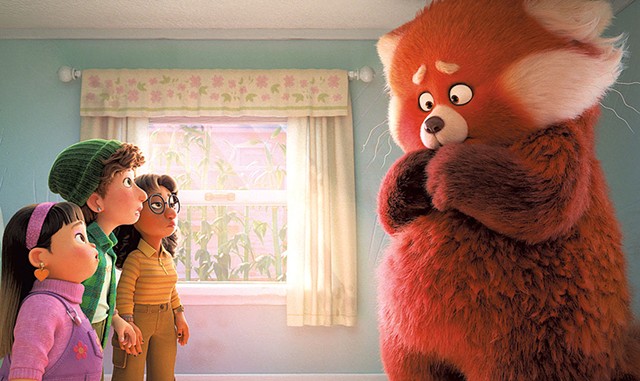
- Courtesy Of Disney/Pixar
- BEARING IT Emotions transform a young girl into an unruly — but adorable! — beast in Pixar's family animation.
I admit it. When I heard there was a social media storm brewing around the new Pixar animation Turning Red, I was instantly interested. While Facebook diatribes declared the film's mentions of menstruation unfit for children, one pastor went so far as to suggest that Turning Red might be "demonic" for depicting the Chinese cultural practice of making offerings to ancestors.
It's a baffling reception — or maybe not — for a movie that puts some rarely represented experiences on-screen. Director Domee Shi (an Oscar winner for her short film "Bao") drew on her own coming of age to create Turning Red, which she cowrote with Julia Cho and Sarah Streicher. Since Disney hasn't released the film in theaters, I watched it on Disney+.
The deal
In 2002 Toronto, 13-year-old Meilin Lee (voice of Rosalie Chiang) leads a double life. At school or under the eye of her mother, Ming (Sandra Oh), Mei is all duty, racking up straight A's and courteously greeting the tourists who come to her family's temple to hear about her illustrious ancestor Sun Yee. With her three best friends, however, she transforms into a loudmouthed hoyden obsessed with a boy band called 4*Town — in other words, a pretty average tween.
One night, Mei finds herself compulsively drawing lovey-dovey cartoons of a cute high school boy. When her mom discovers her creations, worlds collide, and Mei awakens from uneasy dreams to find herself transformed into ... a giant, fluffy red panda.
Turns out, Sun Yee bequeathed to her female descendants a talent for shape-shifting that arrives with puberty and is triggered by unruly emotions. When Mei's family insists that she undergo a ritual to repress her inner panda, Mei isn't so sure. What if she can learn to control the beast within?
Will you like it?
Turning Red is clearly a labor of love — a beautifully animated film that evokes an intense sense of time and place. Instead of the generic North American suburbs that we see in so many cartoons, populated by white people with a sprinkling of "diversity," here we find a realistic 21st-century metropolis. The movie doesn't downplay Toronto's wealth of cultures or its Canadianness; Mei and her friends wear the maple leaf emblem with pride.
Maybe this specificity is what startles some viewers about the film. Or maybe it's the fact that the main characters aren't white. Or maybe some folks would just rather not acknowledge the resonance of the central theme: Puberty is a tumultuous time, and many girls will end up repressing the raging "panda" within.
That theme has been on film before, even in family films. But when Elsa expresses her dangerous emotions in Frozen, she does it by singing a ballad, her princessy dignity intact. Mei turns into a loud, destructive creature that takes up space; the panda's very color references the most embarrassing part of "becoming a woman." Initially misinterpreting her daughter's transformation, Ming shows up at school with a care package of maxi-pads — a scenario straight out of tween nightmares.
So, yes, there's a lot that is cringey in Turning Red, from Mei's naughty drawings to her joyful twerking to the warbles of 4*Town. Some viewers may not be up for that. But who didn't embody the cringe at some point (or all points) in their adolescence?
And the film has no lack of more soothing moments. The cityscapes have a dreamy quality reminiscent of Studio Ghibli, with a pastel palette pretty enough to eat. The scenes in which Mei's dad (Orion Lee) cooks up a feast are mouthwatering, too.
If Turning Red is a coming-of-age story, it's also a mother-daughter story. Mei clashes with her mom and sometimes outright defies her — another element for which the movie has been criticized. But Ming is no cardboard stern matriarch; she has doubts, shadings and a complicated relationship with her own mother (Wai Ching Ho). And she has her own repressed anger, a common ground on which she and her daughter will finally meet.
"We've all got a messy, loud, weird part of ourselves hidden away," Mei tells the audience at the end of the movie. While Marvel has familiarized us all with the concept of "Hulking out," Mei's choice to embrace that part of herself is still unusual for a girl character, and it could help young viewers feel better about their own "messy, loud, weird" parts. Here's to more animated movies that aren't afraid of a little mess.
If you like this, try...
Inside Out (2015; Disney+, rentable): This earlier Pixar film made a surreal foray into the world of a young girl's emotions and discovered that, in fact, they are not all sugar and spice.
Raya and the Last Dragon (2021; Disney+, rentable): Parents seeking an animation inspired by Asian culture without Turning Red's slightly more mature elements could choose this epic fantasy instead. Abominable (2019; Fubo, DirecTV, rentable) is another fun adventure with East Asian characters.
Peppermint Soda (1977; Kanopy, Tubi, Criterion Channel, Cohen Media Channel, rentable): While it may be new for a family animation to acknowledge that tween girls can have sexual feelings, it's not new for cinema in general. The 13-year-old heroine of Diane Kurys' coming-of-age classic can't grow up fast enough.









Comments
Comments are closed.
From 2014-2020, Seven Days allowed readers to comment on all stories posted on our website. While we've appreciated the suggestions and insights, right now Seven Days is prioritizing our core mission — producing high-quality, responsible local journalism — over moderating online debates between readers.
To criticize, correct or praise our reporting, please send us a letter to the editor or send us a tip. We’ll check it out and report the results.
Online comments may return when we have better tech tools for managing them. Thanks for reading.